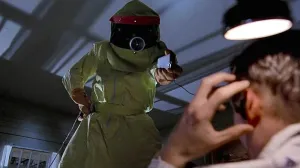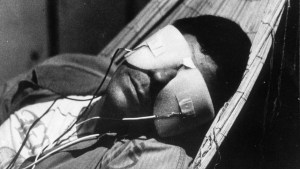Event series have become a staple of comic book storytelling, with countless franchises and rosters of characters uniting to face insurmountable odds. Whether you love them, hate them, or can’t understand the ongoing appeal of them, they have become an undeniable force in comics (and related adaptations). This fact looms over the new Image Comics series Commanders in Crisis, which sets out to tell a crossover story in an entirely new fictional universe, with characters that readers have never encountered before. While it’s an interesting concept, the task can seem either admirable or flat in practice—and in the series’ first issue, it manages to be a little bit of both. Commanders in Crisis #1 lays out just enough narrative and aesthetic groundwork to leave readers wanting more, but doesn’t offer total confidence it will achieve its obvious potential.
Videos by ComicBook.com
Commanders in Crisis follows its titular team of heroes—Originator, Sawbones, Prizefighter, Seer, and Frontier—public figures who fight to keep the world safe from a wide array of extraordinary threats. What the public doesn’t know, however, is that almost all of the heroes are refugees and sole survivors from different places in the Multiverse; they are trying to keep this Earth safe to ward off the Cosmic Sepsis, a flood of violet skies that destroys each Earth it touches. Together, the team stumbles into an unexpected murder mystery, when an unidentified man—who literally represents empathy—is found dead.
Admittedly, that concept can come across as heady or convoluted, especially given how much Commanders in Crisis throws at readers in its first issue. But it is worth applauding how the series approaches each member of the Crisis Command, and that they all feel original on a conceptual level (as it would have been easy to tell this sort of story with half-baked, obvious caricatures of the Avengers or Justice League). At the same time, there are some elements of the ensemble that channel existing Marvel and DC characters—Originator’s powers feel akin to Zatanna and Nico Minoru, Seer will remind fans of both Storm and Wonder Woman, and Frontier feels like the best possible combination of Batgirl and Iron Man. But the series isn’t setting out to lampoon one character or comic trope, instead using those tropes to further develop its characters. When it comes to the plot of the issue itself, readers only receive a mix of crumbs about each character’s schtick, and the big reveal of how they joined forces comes too late in the issue. At least the character concepts are intriguing enough to lead readers to want to see more.
When it comes to the larger world of Commanders in Crisis, what’s covered in the first issue can be underwhelming, as its approach to worldbuilding and introducing threats doesn’t feel sufficiently impactful. Nearly every antagonist or unusual threat in this issue is mentioned in dialogue without being shown, which makes the act of following the parameters and stakes of the series dizzying at times. It’s clear the series is teasing canon and events to be explored in later issues, but in a universe where readers have essentially no frame of reference, it also comes across like watching the season premiere for a show many years into its run.
What we do see in the first issue is an interesting concoction of tones and themes, ones that don’t entirely gel as well as they could. It’s clear that writer Steve Orlando wants to use Commanders in Crisis to touch on themes from his other work, including the refugee experience of Martian Manhunter and Supergirl, the LGBTQ+ journey of Midnighter, and the multiverse-filled cerebral energy of Milk Wars. This issue hammers home the series’ focus on empathy, and on the role that public figures have in society’s relationship to that concept. But while trying to build the world of Commanders in Crisis from the ground up, those themes aren’t explored as deeply as they could be in a different arrangement. There are moments where the series could be read as either an earnest critique or an outrageous parody of our current moment, but instead, it manages to fall somewhere in between.
Davide Tinto’s art certainly provides some strengths, bringing just enough style and flair while grounding the stakes and world. Certain sequences and facial expressions really help the series as it swings between tones, and the cartoony, Overwatch-like costume designs are the right mix of plausible and completely impractical. The one problem with the art is that it doesn’t illustrate how old the members of Crisis Command are supposed to be, as they are simultaneously drawn like a group of bright-eyed young adults and written to be a team of experienced, world-weary heroes. Francesca Carotenuto’s color work is an interesting beast throughout the issue, as the world of the series uses flat color designs to provide vibrancy and brightness. Fabio Amelia’s letters and Fabrizio Verrocchi’s design do a serviceable job of further establishing the series’ energy, but none of it is as visually interesting as the series’ stakes and premise might suggest.
Commanders in Crisis #1 is an interesting debut, trying to establish an Earth-shattering crossover event with an entirely new setting and collection of characters. That act of putting the cart before the horse is undeniably gutsy, but the first issue falls short of delivering a must-read new series. It doesn’t convey the stakes and drama of the event books it’s emulating, nor does it deconstruct the intersection between superheroes and our cultural empathy as strongly as works like Watchmen or The Boys. But there’s just enough here to pique the interest of readers, between the new characters, facets of the art, and unanswered questions surrounding this world. Commanders in Crisis #1 doesn’t do enough to reinvent how readers see event books, but the series to follow just might.
Published by Image Comics
On October 14, 2020
Written by Steve Orlando
Art by Davide Tinto
Colors by Francesca Carotenuto
Letters by Fabio Amelia
Design by Fabrizio Verrocchi








